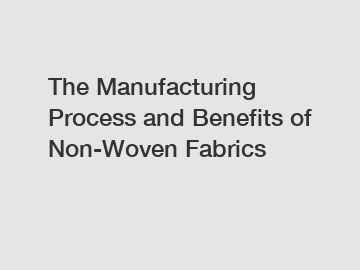The Manufacturing Process and Benefits of Non-Woven Fabrics
The world of textiles is continuously evolving, introducing new materials that cater to our ever-changing needs. Non-woven fabrics have emerged as a remarkable addition, revolutionizing various industries and sectors. From medical and automotive to filtration and packaging, these fabrics offer countless advantages. In this blog, we will delve into the mesmerizing manufacturing process behind non-woven fabrics and explore their exceptional benefits that have made them an indispensable part of modern life.
The Manufacturing Process: An Intricate Blend of Art and Science.
Non-woven fabrics are crafted through an intricate web formation process that sets them apart from traditional woven or knit textiles. This unique process involves several steps, combining art and science to produce fabrics with extraordinary properties.

1. Web Formation: The process commences by forming a web of fibers. These fibers can be made from various materials, including polyester, polypropylene, rayon, or even biodegradable fibers like bamboo or cornstalks. This versatile range of materials allows non-woven fabrics to be tailored to specific requirements.
2. Entanglement: Once the fiber web is formed, it undergoes entanglement, where individual fibers are bonded together. This step can be achieved through several techniques such as needle punching, thermal bonding, or chemical binders. Needle punching involves the use of barbed needles, entwining the fibers together. Thermal bonding employs heat to melt the fibers, creating a bonded fabric. On the other hand, chemical binders utilize specialized adhesives to create a sturdy fabric structure.
3. Finishing Touches: To enhance the characteristics of non-woven fabrics, additional finishing processes may be applied. These can include treatments such as calendaring, coating, or laminating, which offer improved durability, water resistance, and other desirable qualities.
Benefits of Non-Woven Fabrics: Unmatched Versatility and Performance.
1. Cost-Effective Production: One of the remarkable benefits of non-woven fabrics lies in their cost-effective production. The manufacturing process bypasses the need for weaving or knitting, significantly reducing production time and costs. This cost efficiency makes non-woven fabrics a viable choice for a wide range of applications, from disposable medical garments to durable construction materials.
2. Enhanced Strength and Durability: Non-woven fabrics possess exceptional strength and durability, surpassing many traditional woven fabrics. By bonding together individual fiber webs, these fabrics withstand heavy loads, resist tearing, and exhibit high abrasion resistance. This makes them an ideal choice for geotextiles used in road construction, durable automotive components, and protective packaging materials.
3. Outstanding Breathability and Comfort: Non-woven fabrics exhibit excellent breathability due to their interconnected fiber structure. This attribute allows air to circulate, preventing moisture build-up and ensuring excellent ventilation. Consequently, non-woven textiles are widely utilized in the production of disposable hygiene products like diapers, feminine hygiene pads, and surgical gowns.
4. Superior Absorbency and Filtration: The unique web formation technique grants non-woven fabrics superior absorbent properties, making them an effective choice for numerous applications. From oil spill containment to medical dressings and wipes, non-woven fabrics efficiently absorb liquids, ensuring cleanliness and safety. Furthermore, their dense fiber structure provides excellent filtration capabilities, making them an essential component in air and liquid filtration systems.
5. Environmentally Friendly Options: Non-woven fabrics offer eco-conscious alternatives to traditional textiles. Biodegradable fibers, such as those derived from bamboo, cornstalks, or other sustainable materials, provide an environmentally friendly choice for non-woven fabrics. Their biodegradable nature ensures a reduced carbon footprint and lessens environmental impact, making them an ideal choice for disposable products.
Conclusion.
Non-woven fabrics have earned their place as an innovative textile solution, transforming various industries around the globe. Through an intricate manufacturing process combining art, science, and innovative technologies, these fabrics offer unparalleled versatility, strength, and performance. From cost-effective production and enhanced durability to outstanding breathability and absorbency, non-woven fabrics continue to revolutionize numerous sectors.
As we witness the continuous development of non-woven textiles, it is crucial to appreciate the remarkable manufacturing process that brings forth these extraordinary materials. With their ability to adapt to the changing needs of consumers and industries alike, non-woven fabrics are set to pave the way for even more remarkable advancements in the near future.
Are you interested in learning more about material spunbond, isolation gown factory, Sewing Isolation Gown? Contact us today to secure an expert consultation!

Comments